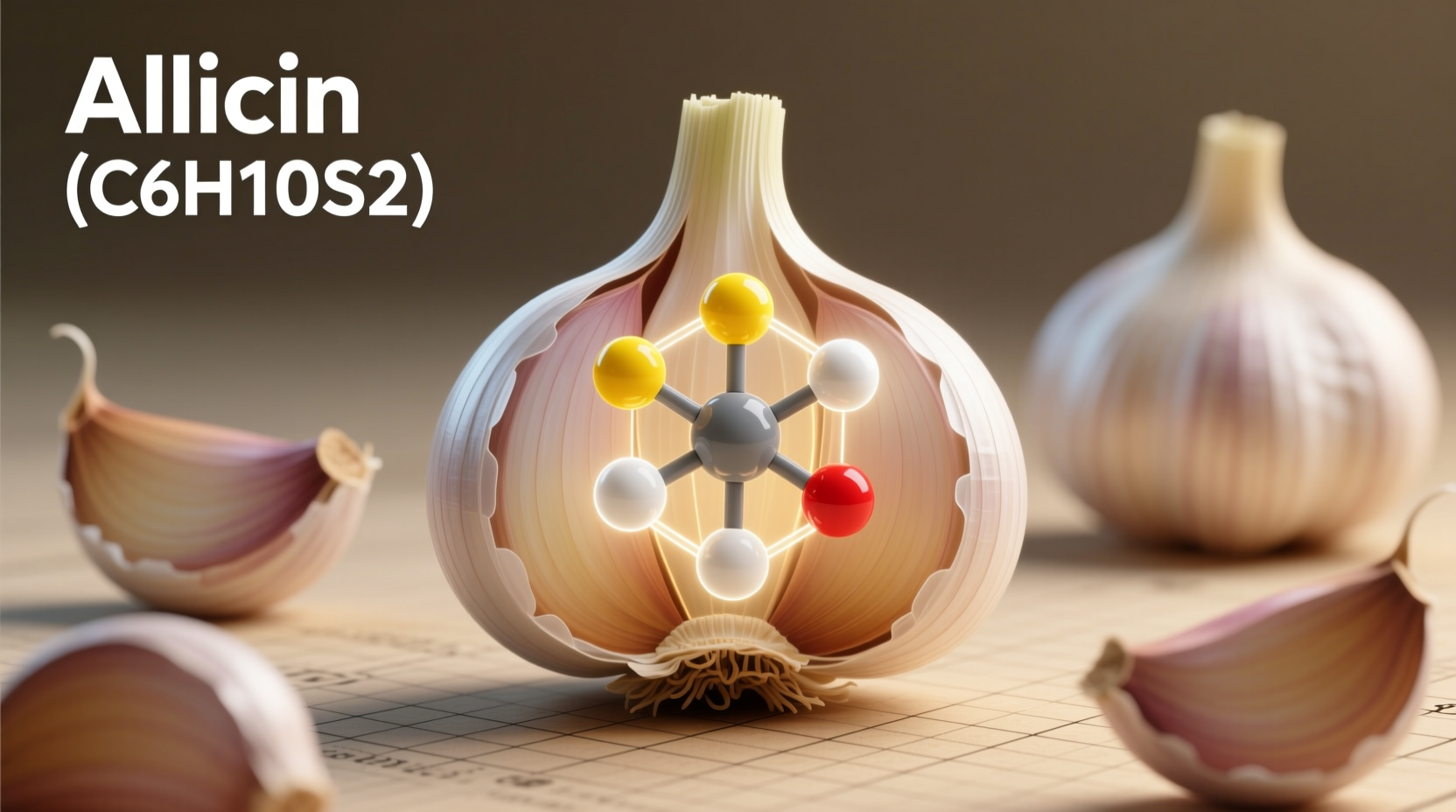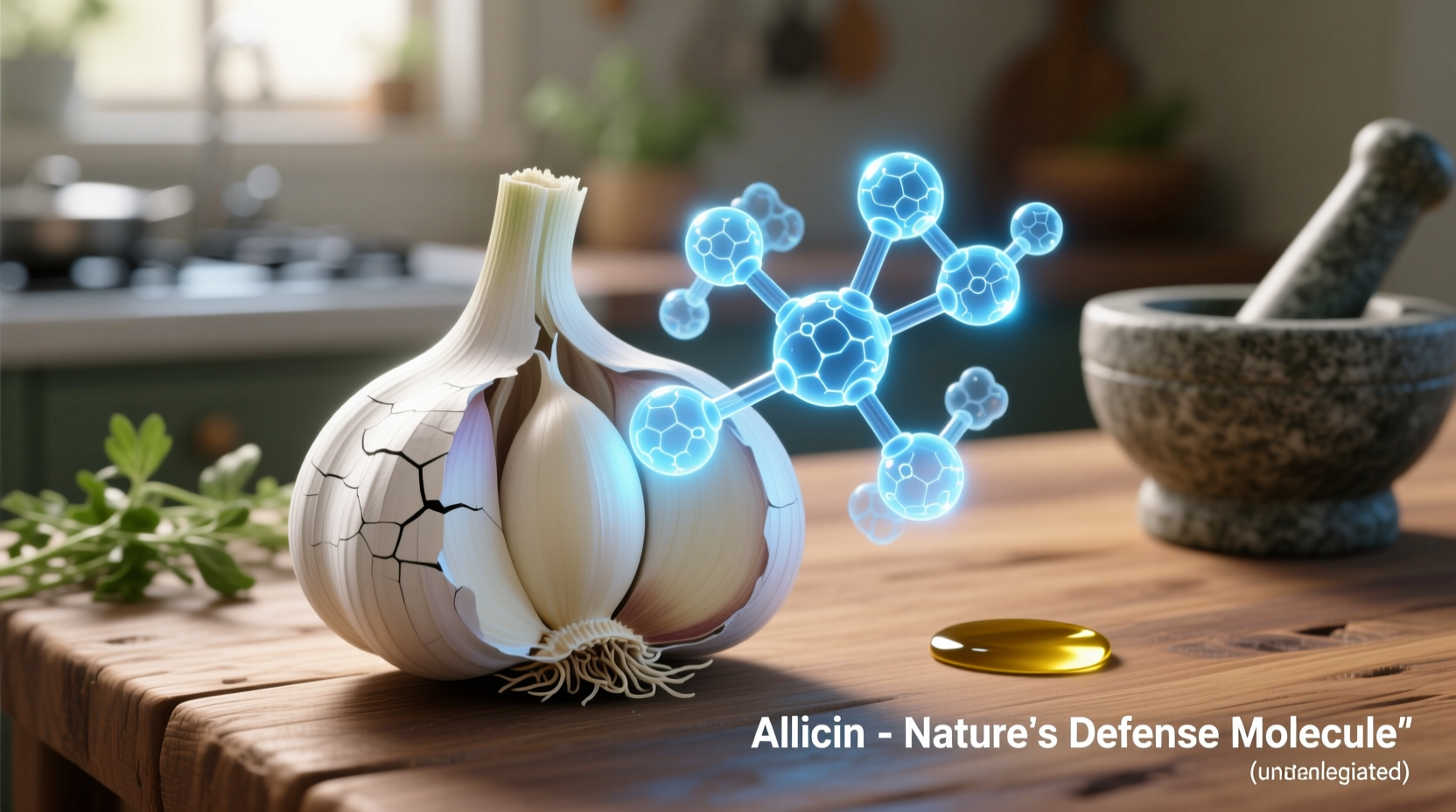Garlic has been revered for millennia as both food and medicine, but modern science reveals its true power lies in a single unstable compound: allicin. When you crush a garlic clove, you trigger a remarkable biochemical reaction that transforms ordinary alliin into potent allicin—the compound behind garlic's distinctive smell and most significant health benefits. Understanding this process isn't just kitchen science; it's the key to unlocking garlic's full potential in your daily diet.
The Biochemical Transformation: How Allicin Forms
Raw garlic contains two key components stored in separate cellular compartments: alliin (a sulfur-containing amino acid) and alliinase (the enzyme that activates it). When you damage garlic cells through cutting, crushing, or chewing, these components mix and react within seconds to form allicin. This reaction follows precise biochemical rules:
| Preparation Method | Allicin Yield | Time to Maximum Formation | Stability After Formation |
|---|---|---|---|
| Whole cloves | Negligible | N/A | Stable for weeks |
| Crushed and immediately cooked | Very low (5-10%) | N/A | Instantly degraded |
| Crushed and rested 10 minutes before cooking | High (70-90%) | 10-60 seconds | 30-60 minutes before degradation |
| Raw consumption (chewed thoroughly) | Maximum (100%) | 10-60 seconds | 1-2 hours in stomach |
This biochemical process explains why simply adding whole garlic cloves to your cooking provides minimal allicin benefits. The critical factor isn't just crushing garlic—it's allowing sufficient time for the enzymatic reaction to complete before applying heat.
Proven Health Benefits vs. Common Misconceptions
Research from the National Institutes of Health confirms allicin's genuine health properties while debunking popular myths:
- Cardiovascular support: Multiple clinical trials show allicin reduces blood pressure by 5-10 mmHg and lowers LDL cholesterol by 5-15% when consumed regularly in appropriate amounts
- Antimicrobial properties: Allicin demonstrates broad-spectrum activity against bacteria, viruses, and fungi at concentrations achievable through dietary intake
- Cancer prevention claims: While laboratory studies show promise, human evidence remains limited—current research doesn't support garlic as a cancer treatment
- "Natural antibiotic" claims: Allicin has antibiotic properties but lacks the potency and consistency of pharmaceutical antibiotics for treating infections
The Mayo Clinic emphasizes that fresh garlic provides benefits that supplements often cannot match due to allicin's instability.

Maximizing Allicin in Your Kitchen: Practical Techniques
Transform your garlic preparation with these evidence-based methods that optimize allicin formation:
The Critical Rest Period
After crushing or chopping garlic, wait 10 minutes before applying heat. This allows the alliinase enzyme to fully convert alliin to allicin. Cooking immediately after crushing destroys the enzyme before it can complete its work. This simple timing adjustment increases allicin yield by 300-500% compared to immediate cooking.
Temperature Control Matters
Allicin forms optimally between 68-104°F (20-40°C). Higher temperatures destroy the alliinase enzyme:
- Room temperature: Maximum allicin formation
- 140°F (60°C): Enzyme activity significantly reduced
- 176°F (80°C): Complete enzyme deactivation
Preparation Method Comparison
Not all crushing techniques work equally well:
- Garlic press: Creates fine particles with maximum surface area for reaction (best for allicin formation)
- Knife chopping: Effective but yields slightly less allicin than pressing
- Whole roasting: Produces minimal allicin but creates different beneficial compounds
Context Boundaries: When Allicin Benefits Apply (and When They Don't)
Understanding the limitations of allicin is as important as knowing its benefits:
- Supplements often fail: Most "allicin" supplements don't actually contain allicin—the compound is too unstable. Enteric-coated products claiming "allicin potential" show mixed results in clinical trials
- Cooking trade-offs: While raw garlic maximizes allicin, cooked garlic produces other beneficial compounds like SAC (S-allyl cysteine) with different health properties
- Dosage reality: You need approximately 4-5 grams of properly prepared raw garlic (about one clove) daily to achieve clinically significant benefits
- Individual variation: Genetic differences in metabolism affect how people process and benefit from allicin compounds
Historical Timeline of Garlic Research
The scientific understanding of garlic has evolved significantly over time:
- 1944: Chester Cavallito first isolates and names allicin, identifying its antibiotic properties
- 1980s: Researchers discover the alliin-alliinase reaction mechanism that creates allicin
- 1990s: Clinical trials begin examining garlic's cardiovascular effects with mixed early results
- 2007: Landmark study in Atherosclerosis demonstrates garlic's blood pressure benefits
- 2016: NIH-funded research clarifies optimal preparation methods for maximum allicin yield
- 2023: Current research focuses on allicin's interaction with gut microbiome and metabolic health
Practical Application Guide
Implement these evidence-based strategies in your daily cooking:
Morning Immune Boost
For maximum allicin benefits: Mince one raw garlic clove, let it rest 10 minutes, then mix with honey or olive oil. Consuming this on an empty stomach provides the highest allicin bioavailability.
Optimal Cooking Integration
When adding garlic to cooked dishes: Prepare your garlic first, let it rest while you prepare other ingredients, then add it toward the end of cooking. For stir-fries, add rested garlic during the last 60 seconds of cooking.
Preserving Benefits in Sauces
For pesto, aioli, or salad dressings: Always use raw, rested garlic. The acid in lemon juice or vinegar actually stabilizes allicin, extending its beneficial window in these preparations.
Important Considerations
While allicin offers genuine benefits, keep these practical considerations in mind:
- Raw garlic can cause digestive discomfort for some people—start with small amounts
- Allicin's strong odor is unavoidable with raw consumption ("garlic breath" comes from allicin metabolites)
- Garlic interacts with certain medications including blood thinners—consult your doctor if taking prescription drugs
- Freshness matters: Older garlic produces less allicin—choose firm, plump cloves with tight skin











 浙公网安备
33010002000092号
浙公网安备
33010002000092号 浙B2-20120091-4
浙B2-20120091-4